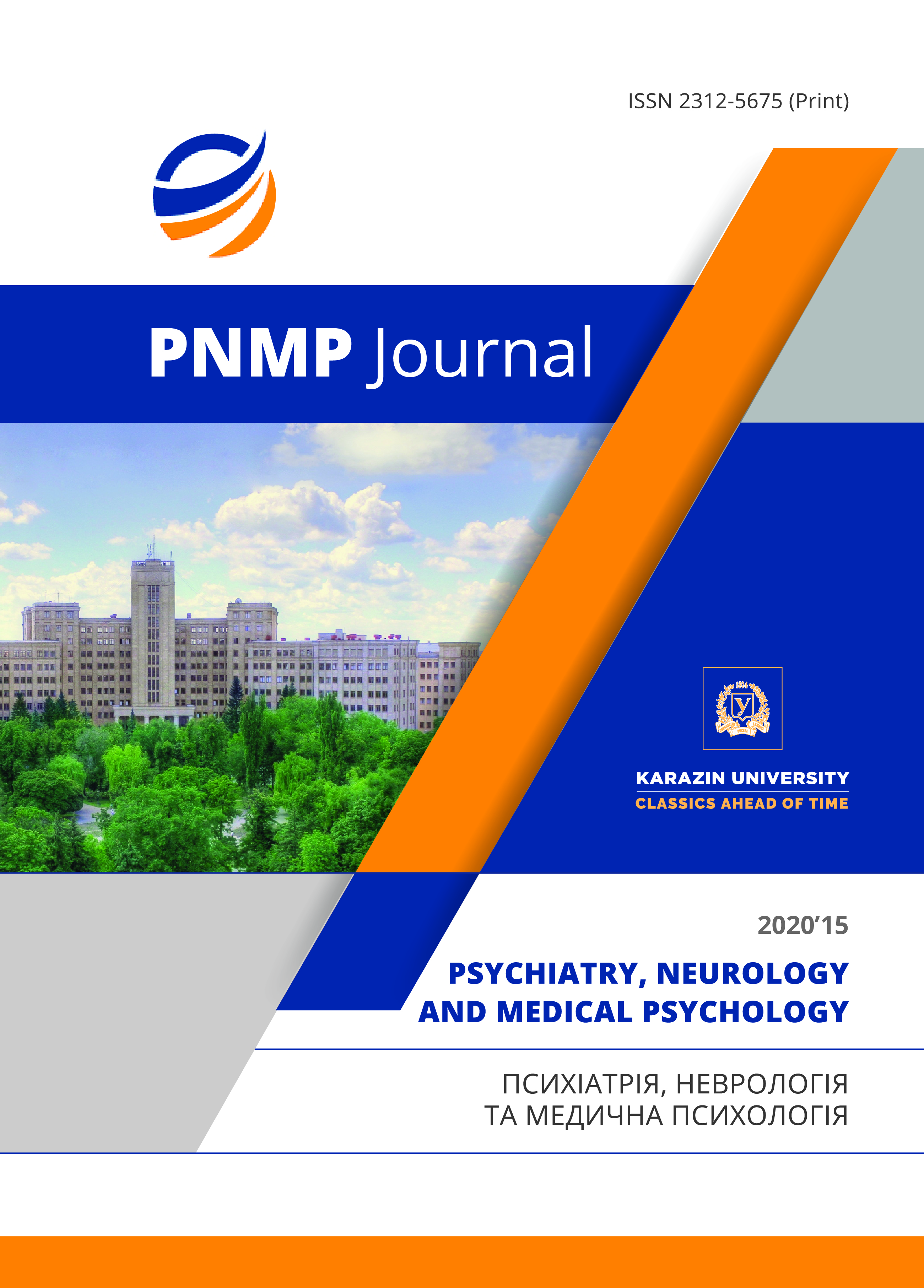Objective assessment of the therapy effectiveness for patients with depression based on the analysis of their involuntary reactions during a combined psychodiagnostic and psychophysiological study
Abstract
The aim of this work was the development a method for objective assessment of therapy effectiveness for patients with depression based on measurements of reaction time and other parameters of involuntary response to audiovisual stimuli in the process of combined psychodiagnostic and psychophysiological investidation.
97 patients with depression (main group) were examined, at an average age of 40.94 ± 1.25 years (among them 51 persons diagnosed with “depressive episode” (F32 by ICD-10) and 46 persons with “recurrent depressive disorder” (F33 by ICD-10), as well as 64 almost healthy individuals (control group), at age 41.21 ± 1.21 years. Clinical-psychopathological, psychometric (computer versions of: Zung’s scales, HADS, Spielberger tests in Khanina modification, AUDIT and SCL-90R), and psychophysiological methods were used, the latter method involved the use of software and hardware complex "Reocom-stress" (manufacturer: " XAI-MEDICA", Kharkiv, Ukraine) in the "Attitude to the topic" mode with registration of psychophysiological response to groups of questions (thematic groups) from the above-mentioned psychometric methods. The described procedure was used twice during the study: with an interval of 17-19 days.
It was shown that the response time and other parameters of involuntary response to audiovisual stimuli are valuable sources of information for quality control of the therapy effectiveness for patients with depression. And three channels of information (scale scores, and response time to questions in psychodiagnostic investigation and attitude to the topics (the questions of the mentioned scales), and assessed by the results of psychophysiological research) are relatively independent of each other and carry additional information about the mental status of the respondents. We found out that the channel of mental chronometry is the most sensitive to residual depressive symptoms. It has been proven that the best choice for objective assessment of therapy effectiveness for patients with depression is a computer version of the Zung’s scale with registration of the response time to each questions of this scale. This approach has the highest diagnostic properties (sensitivity — 86.60%, specificity — 96.88% and accuracy — 90.68%), which, together with the simplicity of implementation, makes it quite suitable for practical use.
Downloads
References
WHO, 2017. Fact sheet – 02/2017 / World Health Day 2017 Depression let's talk/ (Електронний ресурс: https://deputyprimeminister.gov.mt/en/dhir/Documents/World Health Day 2017 Depression let's talk.pdf).
Mishiev V.D. Modern depressive disorders. Lviv: MS Publishing House. 2004, 208 p.
Yurieva L.N. Clinical suicidology (monograph). Dnepropetrovsk: "Thresholds". 2006, 472 p.
Gilbody S, Sheldon T, Wessely S. Should we screen for depression? 12. BMJ. 2006, no. 332, pp. 1027 – 1030. DOI: 10.1136/bmj.332.7548.1027.
Jensen A.R. Clocking the mind: mental chronometry and individual differences. Elsevier Science. 2006, p.286.
Maruta N.O., Linska K.I. Chronometric profile of patients with depression using a computer version of the Tsung scale and its diagnostic value. Ukrainian Bulletin of Psychoneurology. 2018, vol. 26, no. 4 (97), pp. 57-65.
Maruta N.O., Linska K.I. Diagnostic value of response time to questions in patients with depression using a computer version of the HADS scale. Psychiatry, psychotherapy and clinical psychology. 2019, vol. 10, no. 2, pp. 337-352. DOI: 10.14739/2310-1210.2020.3.204950
Linska K.I. Chronometric profile of patients with depression when using the Spielberger-Khanin test. Ukrainian Bulletin of Psychoneurology. 2019, vol. 27, no. 1 (98), pp. 57-65.
Linska K.I. Attitude to verbal and nonverbal sound stimuli and reaction time to them as diagnostic markers of depression in patients. Medical Psychology. 2019, no. 1, pp. 62-73.
Linska K.I. The attitude of patients with depression to topics related to their mental status, according to the results of psychophysiological research. Medical Psychology. 2019, vol. 14, no. 3 (55), pp. 58-69.
Churkin A.A. A brief guide to the use of ICD-10 in psychiatry and addiction. A.A Churkin, A.N. Martyushov. M .: - "Triad-X". 2002, 232 p.
Hamilton, M. A rating scale for depression. // Journal of Neurology, Neurosurgery and Psychiatry. 1960, vol. 23, pp. 56-62. DOI: 10.1136/jnnp.23.1.56
Montgomery SA, Asberg M. A new depression scale designed to be sensitive to change. British Journal of Psychiatry. 1979, vol. 134, pp. 382-389. DOI: 10.1192/bjp.134.4.382
Beck, A.T., Steer, R.A., Brown, G.K. Beck Depression Inventory-II. San Antonio, TX: Psychological Corporation. 1996, 69 p. DOI: 10.1080/00223890802248919
Mezzich Juan E., Cohen Neal, Liu Jason, Ruiperez Maria, Yoon Gihyon, Iqabal Saeed, Perez Carlos. Validization an efficient quality life index. Abstracts XI World Congress Psychiatry «Psychiatry on New Thresh-olds». - Hamburg, Germany, 6-11 August 1999, pp. 427-428.
Derogatis L.R.; Savitz, K.L. “The SCL-90-R and the Brief Symptom Inventory (BSI) in Primary Care”. In Maruish, Mark Edward (ed.). Handbook of psychological assessment in primary care settings. Mahwah, NJ: Lawrence Erlbaum Associates. 2000, pp. 297–334.
Tarabrina N.V. Workshop on the psychology of post-traumatic stress. St. Petersburg: Peter. 2001, 272 p.
Zung W.W. A self-rating depression scale. Archives of General Psychiatry. 1965, no. 12, pp. 63-70. DOI: 10.1001/archpsyc.1965.01720310065008
Zigmond A.S., Snaith R.P. "The hospital anxiety and depression scale". Acta Psychiatrica Scandinavica. 1983, vol. 67, no 6, pp. 361–370. DOI: 10.1111/j.1600-0447.1983.tb09716.x.
T.F. Babor, J.C. Higgins-Biddle, J.B. Saunders et al. AUDIT - The Alcohol Use Disorders Identification Test. Guidelines for Use in Primary Care. Second Edition. World Health Organization. Department of Mental Health and Substance Dependence. 2001.
Krylov A.A., Manichev S.A. Workshop on General Experimental and Applied Psychology: Textbook. allowance. St. Petersburg: Peter Publishing House. 2000, 560 p.
Scientific and Technical Center of Radio-Electronic Medical Equipment and Technologies “HAI MEDICA” [Electronic resource]. Polygraph REOKOM STRESS - Mode of access to the resource: https://hai-medika.prom.ua/p358078095-poligraf-reokom-stress.html.
Gubler E.V. Computational methods of analysis and recognition of pathological processes. M .: Medicine. 1978, 294 p.
S.N. Lapach, A.V. Chubenko, P.N. Babich. Statistical methods in biomedical research using Excel. Kiev: "Morion". 2000, 320 p.

